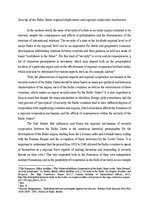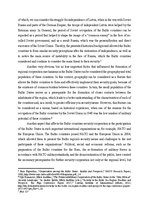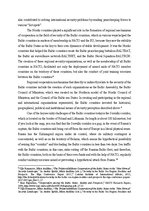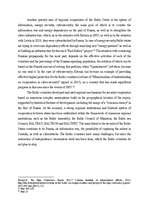-
Security of the Baltic States - Regional Implications and Regional Cooperative Mechanism
The situation with countering Russian propaganda, for the most part, depends on the effective activities of each of the countries and the percentage of the Russian-speaking population, the solution of which can be based on the Finnish success of solving this problem, when “Sputniknews”, left there, because
no one read it. In the case of cybersecurity, Estonia can become an example of providing effective digital protection for the Baltic countries (on base of “Memorandum of understanding on cooperation in cyber-security” signed in 2015), as a country that has made significant progress in this area since the events of 2007.12
The Baltic countries developed and used regional mechanisms for security cooperation based on numerous complex assumptions build on the geographical location of the region, supported by historical features of development, including the image of a “common enemy” in the face of Russia. At the moment, a strong regional institutional and bilateral system of cooperation between states has been established within the framework of numerous regional
institutions, such as the Baltic Assembly, the Baltic Council of Ministers, the Baltic sea Council, BALTBAT, BALTRON and BALTNET. The main threat to the security of the Baltic States continues to be Russia, its information war, the possibility of capturing the salient in Suwalki, as well as cyberattacks. The Baltic countries have many challenges, but since the
restoration of independence, tremendous work has been done, which the Baltic countries do not plan to stop.Prospects.…
The first feature that influences and forms the regional mechanism of security cooperation between the Baltic States is the numerous historical prerequisites for the development of the Baltic region, starting from the Livonian order and Swedish times, ending with the Russian Empire and the occupation of these territories by the Soviet Union. It is important to understand that the period from 1918 to 1940 allowed the Baltic countries to speak of themselves as a regional force capable of making decisions and responding to security threats on their own. This was expressed both in the formation of their own independent military formations, and in the possibility of cooperation in the field of security, as an example of which, we can consider the struggle for independence of Latvia, when in the war with Soviet Russia and parts of the German Empire, the troops of independent Latvia were helped by the Estonian army. In General, the period of Soviet occupation of the Baltic countries can be regarded as a period that helped to shape the image of a “common enemy” in the face of so-called Soviet government, and as a result Russia, which was the personification and direct successor of the Soviet Union. Thereby, the presented historical background allowed the Baltic countries to form similar security perceptions after the restoration of independence, as well as to notice the main source of instability in the face of Russia, which the Baltic countries considered and continue to consider the main threat to their security. Another very obvious, but no less important factor that influenced the formation of regional cooperation mechanisms in the Baltic States can be considered the geography and total population of these countries. In this context, geography can be considered as a feature that allows the Baltic countries to form and effectively implement their security goals, because of the existence of common borders between these countries. In turn, the small population of the Baltic States serves as a prerequisite for the formation of closer contacts between the inhabitants of the region, which leads to a better understanding of the characteristics of each of the countries and, as a result, to greater efficiency in security issues. However, this feature can be considered as a minus, based on historical experience, when one of the reasons for the occupation of the Baltic countries by the Soviet Union in 1940 was the low number of military potential of these countries.
PDF formāts.




